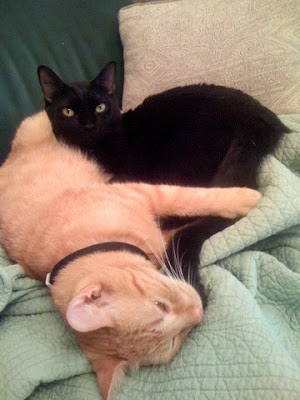 About 4 years ago we lost the second of our two cats. Charcoal and Grace had been with us for 16 and 18 years respectively and when Grace finally passed away, it was really hard on us.
About 4 years ago we lost the second of our two cats. Charcoal and Grace had been with us for 16 and 18 years respectively and when Grace finally passed away, it was really hard on us.But in time I began to heal, and about 6 months later I started wanting kittens. Everywhere I went, I saw kittens. It was like an obsession. However, Jim was very unsure about getting kittens, because he had only ever had cats that people had given him when they were adult.
So we went back and forth for a while, with me wanting and him doubting until finally on one of our trips to the pet store so I could pet the kittens, I hit on the perfect solution. I bought him a book called Kittens for Dummies by Dusty Rainbolt.
My husband and I are alike in that if you give us a "How To" book, we can rule the world. Now, as cheesy as this book sounds, it actually had some incredible information in it that has really helped us (when we finally did get the kittens) to raise the healthiest, most active, most relationship-oriented cats that we have ever had in either of our lives. And so I'm going to paraphrase some of the most important things we learned from the book, and from Athos and Porthos our two kittens who will be 3 years old in March.
The first and most important thing we learned was what to feed your cat. Cats (unlike humans or dogs) are obligatory carnivores. They cannot eat anything except meat and are used to getting all of their food and water from their kills. The ideal food to feed your cats would be ground up mouse or bird. However, that is not so easy to find unless you make your own (Eeeeuuuuwww!) The second best thing to feed your cats is a combination of wet and dry food with as much protein and as little of anything else as possible.
However, if you actually go and read the ingredients in most cat food the primary ingredients are usually various types of corn or grains which cats cannot digest. If your cat is eating what he cannot digest it is going to come right out the other end as stinky poop, and you cat is going to put on weight because his body will think he is starving. (This works exactly the same way for humans when we eat a lot of sugar and nutritionally empty carbs.) So my husband and I went on a label reading expedition to the various pet stores and grocery stores to find the highest protein content foods with the least amount of chemical additives. We came up with three options, Purina Pro Plan (not the regular Purina), Eukanuba, and Blue Wilderness that had 40-50 percent protein. A lot of the big name brands like Science Diet, are quite frankly absolute junk, if you stop and read the ingredients.

We started with the Eukanuba when they were kittens and it did really well for us, but then they had the big recall and so we switched to the Purina Pro Plan. They actually like the Pro Plan much better, although we found we had to buy the dry food in small containers because it would actually spoil in the time it took to use a large container and would make them sick at the end. Well, experience has proved very successful. Out of all our friends we have the thinnest, and most active cats for their age (though you couldn't tell that from the pictures I've put up).
The second most important thing we learned was how to communicate with your cat. Cats have a hierarchical society and certain behaviors like staring are dominance behaviors. If you stare at your cat, you are being very rude in cat language. That is why cats will always go over to the person who doesn't like them and isn't looking at them, because that person is actually being polite in cat language. If you do stare at you cat, you can break up your dominance message into one of affection by long slow blinks. These are like kitty kisses (if you have cats, I bet you see them doing this to you). My husband and I tried experimenting by meeting the kittens' eyes from across the room and then doing a series of long slow blinks. Almost every time, the kittens would make little proots of affection and coming running over for attention.
Also, cats usually grow to understand some human words, but "NO" is not one of them. If you want to discourage a bad behavior the best way to do so is to stare furiously at the cat and hiss long and loud. It makes perfect sense, if you think about it, to communicate with them the same way they communicate with each other rather than expecting them to learn our language. After all we do have the bigger brains... I think.

The third tip we picked up that was invaluable was about personal space and relating to young kittens. The book suggested that you never rough house with kittens with your naked hands. You can still play with the cats, but the suggestion was to always use a glove, or play with them under the sheets because that way your kitten only associates naked hands with petting, and never with biting. We have done this and it works like a charm. Our cats may have other bad behaviors, but they never, ever bite, not even when they are under a lot of stress. From experience we also learned that if you let the kitten walk all over you and climb on you when they are young, they will have much less sense of personal space be much more physically affectionate when they are older.
We have also picked up some wonderful ideas for cat grooming and maintenance along the way. We have tried about every type of cat litter and litter alternative in the universe and Fresh Step (the unscented and undyed version is by far the best.) It has almost no odor even when the box is full, and is the closest to what cats are used to using in the wild to bury their poop. Also when it comes to living with cats, on of the best tricks is to gently trim their claws with a nail clipper once a week. If you establish trust early on, this is easy to do when they get in a sleepy mood and can be a great time for petting as well. I think declawing a cat is just cruel. How would you like to have all your fingers amputated at the last joint? Thanks, I'd rather buy new furniture.
And for behavior, cats are smart. I mean really smart. And unlike dogs, they get bored easily, and do not necessarily need your attention. So if you want to play with your cats, you always need to be slightly changing the game to keep it interesting. For example, if they get bored with a toy, take a box an cut some holes in it and but the toy inside it. You can also teach them to do things like fetch little toys or pieces of paper. Dingo kitty treats which are made from dried beef and chicken are great for cat training. We have trained ours so that when we let them outside in the back yard, they will come when they are called.
The last interesting that we learned is that cats tend to be matriarchal. Our kittens have pretty much adopted my husband as their third brother, but they have a much more complex relationship with me because for them I am the one in charge. (Or maybe that is just about me :)
If you have female cats this dominance can become an issue between different female cats, or between cats and humans. Our last two cats were both female and during the 12 years we had them together they barely grew to tolerate each other, and refused to share the same space. It was very sad.
But now we have our mouseketeers and they are absolutely the delight of our lives, and God willing, they will be with us for many years to come.



No comments:
Post a Comment